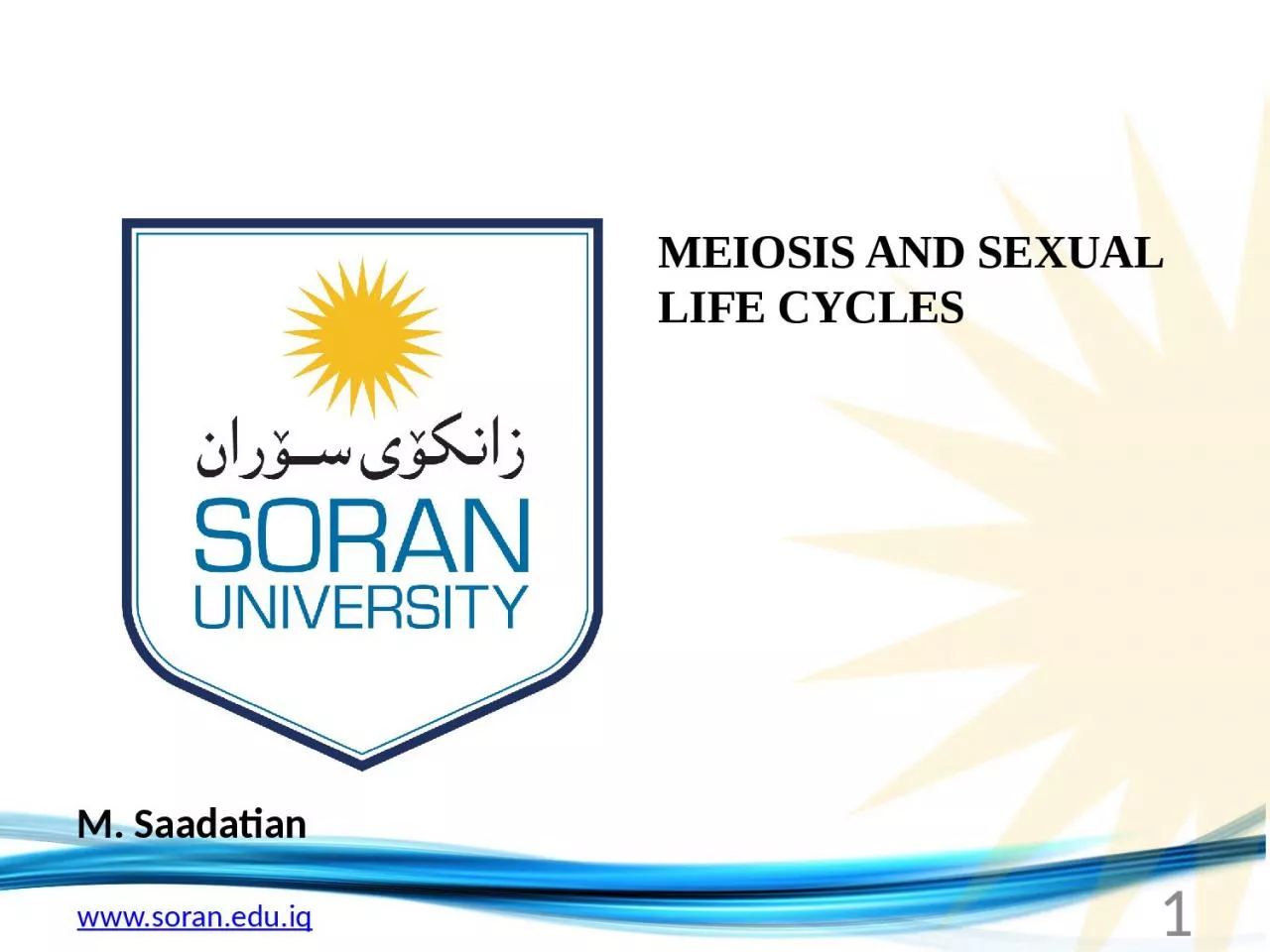

1 MEIOSIS AND SEXUAL LIFE CYCLES Heredity Continuity of biological traits from one generation to the next Variation Inherited differences among individuals of the same species Genetics ID: 934193
Download Presentation The PPT/PDF document "M. Saadatian MEIOSIS AND SEXUAL LIFE CY..." is the property of its rightful owner. Permission is granted to download and print the materials on this web site for personal, non-commercial use only, and to display it on your personal computer provided you do not modify the materials and that you retain all copyright notices contained in the materials. By downloading content from our website, you accept the terms of this agreement.
Slide1
M. Saadatian
MEIOSIS AND SEXUAL LIFE CYCLES
1
Slide2MEIOSIS AND SEXUAL LIFE
CYCLES
Slide3Heredity
= Continuity of biological traits from one generation to the nextVariation
= Inherited differences among individuals of the same
species
Genetics
= The scientific study of heredity and hereditary
variation
DNA
= Type of nucleic acid that is a polymer of four different kinds of nucleotides.
Genes
= Units of hereditary information that are made of DNA and are located
on chromosomes.
Locus
= Specific location on a chromosome that contains a
gene
Somatic cell = Any cell other than a sperm or egg
cell
Homologous chromosomes (homologues) = A pair of chromosomes that have
the same
size,
centromere
position, and staining pattern.
Slide4Autosome
= A chromosome that is not a sex chromosome.Sex chromosome = Dissimilar chromosomes that determine an individual's
sex
Diploid
= Condition in which cells contain two sets of chromosomes; abbreviated
as 2n
Haploid
= Condition in which cells contain one set of chromosomes; it is
the chromosome
number of gametes and is abbreviated as n
Gamete
= A haploid reproductive
cell
Gametes are the only cells in the body that are not produced by mitosis.
Zygote
= A diploid cell that results from the union of two haploid gametes
Slide5Slide6Slide7Though the processes of mitosis and meiosis are similar in some ways, there
are some key differences
• Meiosis
is a reduction division. Cells produced by mitosis have the
same number
of chromosomes as the original cell, whereas cells produced
by meiosis
have half the number of chromosomes as the parent cell.
• Meiosis creates genetic variation. Mitosis produces two daughter
cells genetically
identical to the parent cell and to each other. Meiosis
produces four
daughter cells genetically different from the parent cell and from
each other
.
• Meiosis is two successive nuclear divisions. Mitosis, on the other hand,
is characterized
by just one nuclear division.
Slide8Slide9Origins of Genetic Variation
A. Sexual
life cycles produce genetic variation among
offspring
1. Independent assortment of
chromosomes
Independent assortment = The random distribution of maternal and
paternal homologues
to the gametes. (In a more specific sense, assortment refers to
the random
distribution of genes located on different chromosomes
.)
At metaphase I, each homologous pair of chromosomes aligns on the
metaphase plate
. Each pair consists of one maternal and one paternal chromosome.
• The orientation of the homologous pair to the poles is random, so there
is a
50-50 chance that a particular daughter cell produced by meiosis I
will receive
the maternal chromosome of a homologous pair, and a
50-50 chance
that it will receive the paternal chromosome.
Slide102. Crossing
overCrossing over = The exchange of genetic material between homologues; occurs during
prophase of meiosis I
.
3. Random
fertilization
Random fertilization is another source of genetic variation in
offspring
In humans, when individual ovum representative of one of eight
million possible
chromosome combinations is fertilized by a sperm cell, which
also represents
one of eight million
possibilities.
Slide11B. Evolutionary adaptation depends on a population’s genetic variation
Heritable variation is the basis for Charles Darwin's theory that natural selection is
the mechanism
for evolutionary change. Natural selection:
• Increases the frequency of heritable variations that favor the
reproductive success
of some individuals over others
• Results in
adaptation, the accumulation of heritable variations that are favored
by the environment
• In the face of environmental change, genetic variation increases the
likelihood that
some individuals in a population will have heritable variations that
help them
cope with the new conditions.
There are two sources of genetic variation:
1. Sexual reproduction. Results from independent assortment in meiosis I, crossing
over in prophase of meiosis I, and random fusion of gametes
during fertilization
.
2. Mutation, which are random and relatively rare structural changes made during
DNA replication in a gene could result from mistakes.